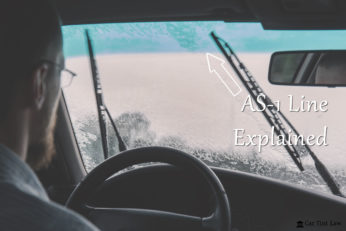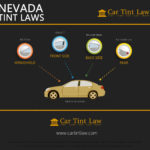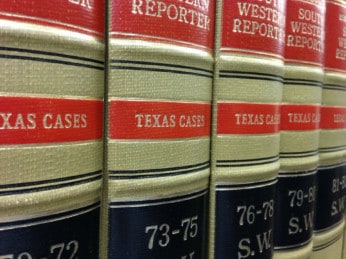Our Nevada window tint laws are valid for 2024. These laws regulate how dark and reflective your car tint may be, but also specify other rules and regulations you need to know about.
| Nevada Tint Laws | |
|---|---|
| Front Windshield | AS-1 line |
| Front Side Windows | 35% |
| Back Side Windows | No restrictions |
| Rear Windshield | No restrictions |
Last updated on: . Confirmed accurate for 2024.
How dark can your window tint be in Nevada?
Window tint darkness is measured by Visible Light Transmission percentage (VLT%). In Nevada this refers to the percent of visible light allowed in through both the film and the glass.
Drag the slider above to preview tint darkness. In most cases, applied tint will appear 5-15% darker.
See: VLT explained with chart and darkness examples
Here's exactly how much VLT is allowed on your auto window tint in Nevada (NV), categorized by passenger and multi-purpose vehicles.
Tint darkness for passenger vehicles:
- Windshield: Non-reflective tint is allowed above the manufacturer's AS-1 line.
- Front Side windows: Must allow more than 35% of light in.
- Back Side windows: Any darkness can be used.
- Rear Window: Any darkness can be used.
Passenger vehicles include sedan, coupe, convertible, station wagon, hardtop and hatchback vehicles.
Tint darkness for multi-purpose vehicles:
- Windshield: Non-reflective tint is allowed above the manufacturer's AS-1 line.
- Front Side windows: Must allow more than 35% of light in.
- Back Side windows: Any darkness can be used.
- Rear Window: Any darkness can be used.
Multi-purpose vehicles include SUV, pickups, vans, RVs, and minibuses.
AS-1 line typically extends 4-6 inches parallel to the top of your windshield. AS-1 designation line is typically marked in bottom or top edge of your windshield.
Some state tint laws specify exact number of inches you are allowed to tint on front windshields. Other states define this windscreen area simply as an AS-1 line. Learn more about AS-1 Line.
Federal vehicle ID label found on driver's front door frame will tell you whether your vehicle is classified as passenger or multi purpose vehicle.
How reflective can your window tint be in Nevada?
Tinting film may contain metallic elements which help in reflecting incoming light. This reduces glare and heat generated by visible light. Below you can find out how much reflection is permitted on your car window tint film by law in Nevada.
Tint reflection for sedans:
- Front Side windows: No reference to reflectivity in the current law.
- Back Side windows: No reference to reflectivity in the current law.
Tint reflection for SUV and vans:
- Front Side windows: No reference to reflectivity in the current law.
- Back Side windows: No reference to reflectivity in the current law.
Learn about Reflective window tint.
Other Nevada tinting rules and regulations:
Other laws, rules and regulations in Nevada include the following:
Dual side mirrors are required if back window is tinted.
Colors RED and AMBER are not permitted.
Manufacturers of film need to certify the film they sell in Nevada. Ask your dealer if they are using certified film.
No sticker to identify legal tinting is required.
Nevada allows medical exemptions for special tint. For more details about the specific terms of the exemption, consult your state law.
Remember that state tint laws may be interpreted differently by your local law authorities. Get in touch with your county DMV or police department to make sure you are not breaking Nevada window tinting laws, rules and regulations.





